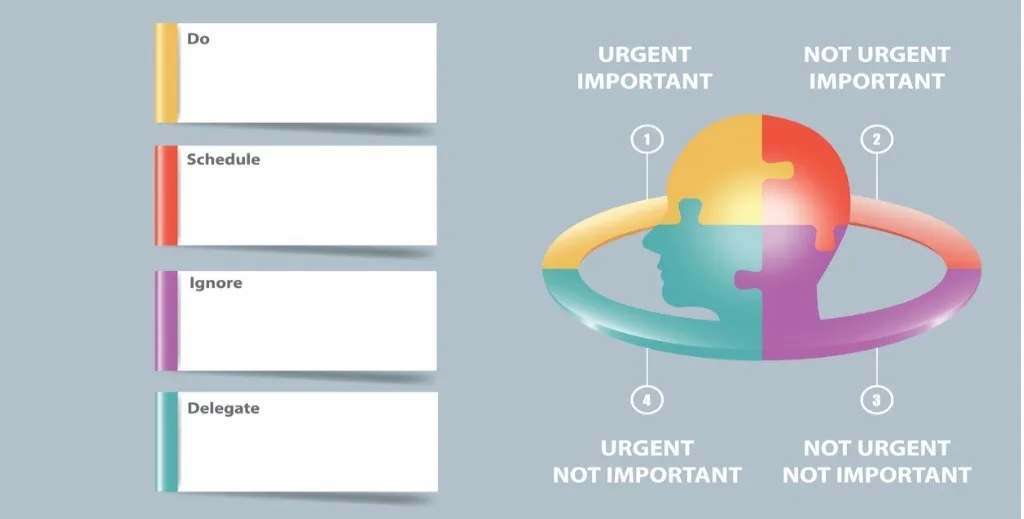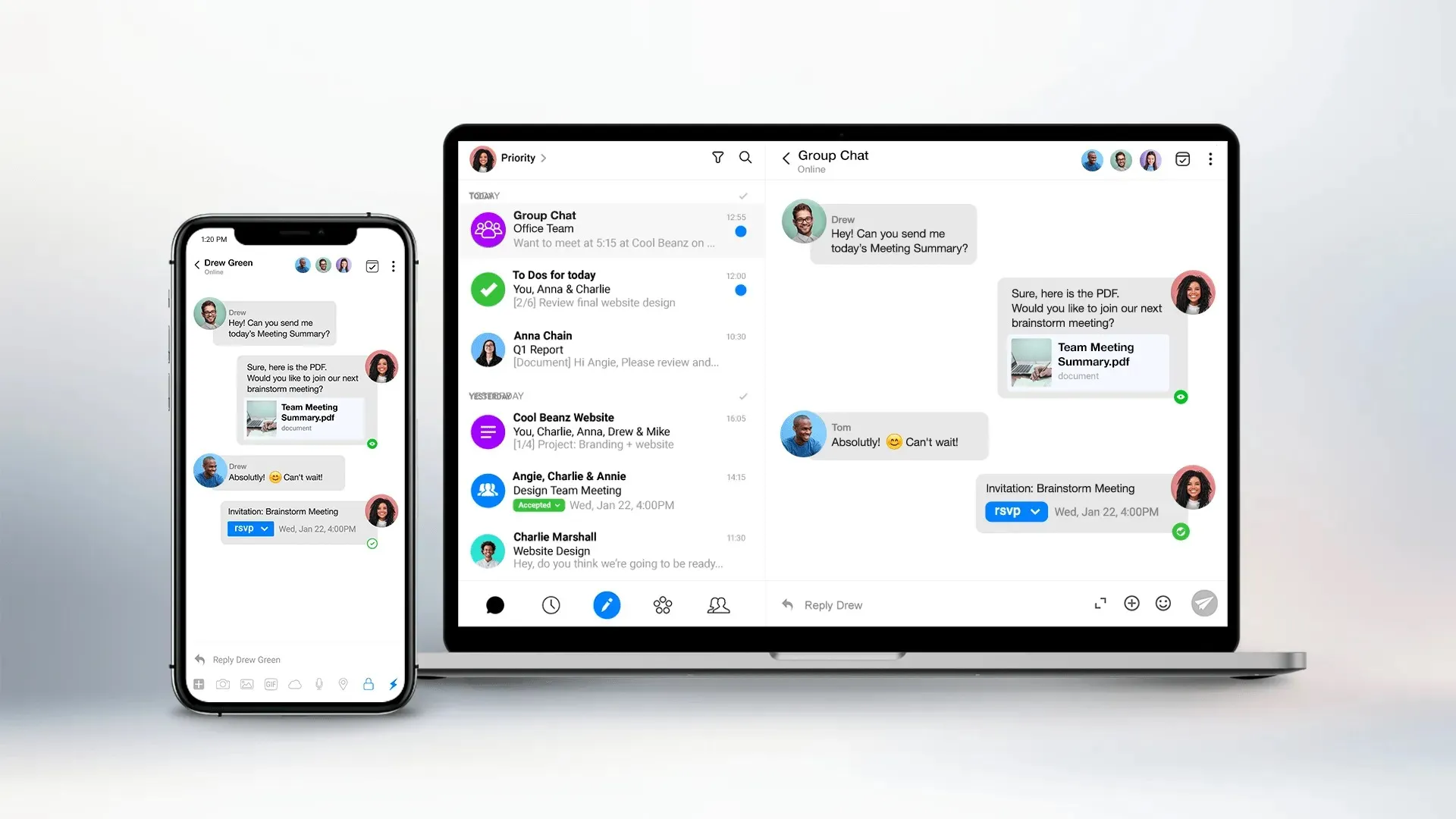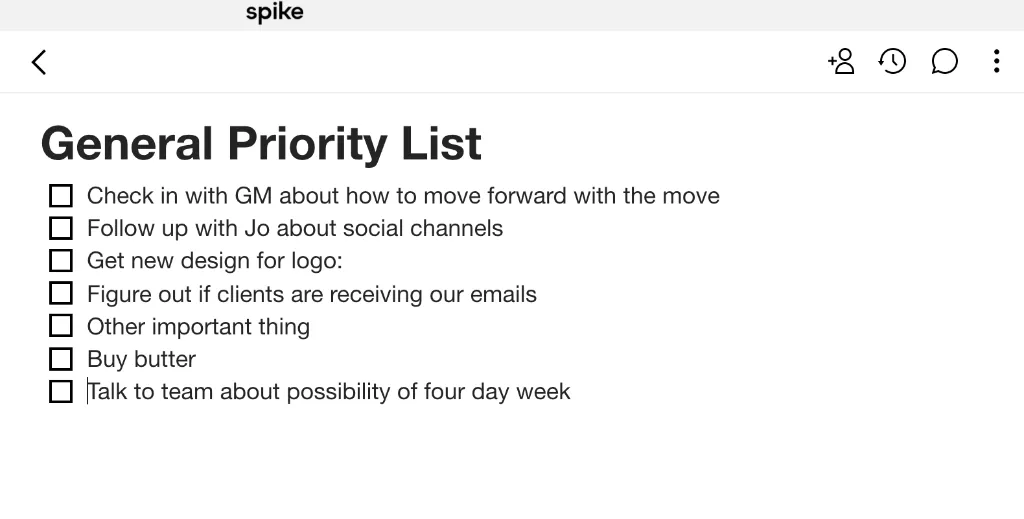How to Create and Manage a Priority List

A priority list helps you get organized, stay focused, delegate tasks, and cut the fat. It allows you to visually break down what you have to do and when you have to do it—helping you to manage tasks based on importance.
But let’s face it, you’re probably already well aware of a simple priority list, and you probably use them every day in your job. However, the kind of priority lists we’re talking about goes way beyond the scribbled notes you may be used to. Spike is taking them to the next level, integrating them into a full-blown productivity system to get your work done.
But before we dive into how you can create next-level priority lists, let’s take a look at why they should matter to you.
3 Reasons to Create a Priority List
Priority lists are a straightforward and clean way to manage your work and the work of your team. There are numerous benefits that properly a structured workday can bring, but three of the main things that a prioritized list can do are:
-
Organize your tasks
Even the most elegant lists can become overwhelming if you don’t know where to start. It can often be the case that there is just so much to do; it’s easier not to start at all.
Priority lists allow you to understand where to begin and what can be cut using intuitive visualizations. A single glance can give you a high-level overview of everything you and your team need to do without wasting time digging down into the details. But, at the same time, priority lists narrow things down enough that if you need to focus, you can have just a single task for the day.
-
Keep you Focused Through the Day
The impact of feeling overwhelmed by work can include forgetfulness, confusion, difficulty concentrating, and impaired ability to problem solve, and much more. When we demand too much from our brains, cognitive fatigue kicks in, and focus is lost.
This issue of being overwhelmed, of having “too many demands”, is something that priority lists can tackle almost instantly, simply by bringing more structure to your tasks. No longer are they coming at you all at once, but instead, they are laid out one after the other, allowing you to put all your focus on the job at hand and cut down on task mixing.
-
Helps you Delegate
Priority lists can help you establish two critical things for delegating:
1) How important is a task?
2) How soon does this task need to be done?
If the answers are “not very” and “right now,” delegating becomes a simple choice. This can be the most helpful thing in the world for those who are hesitant to trust since clear priorities leave clear decisions. Priority lists also help clarify what exactly to delegate so your team doesn’t end up with small, unimportant, or out-of-sync tasks.
How to Create a Priority List

The first step in creating the most efficient priority list possible is to write down all the tasks you have—every single one. If you’re organizing work for a company, this should generally be business-based tasks, but if you’re going solo, feel free to include everything. Need to replace the fridge? Add it. New cat brush? Add it. Phone a friend? Add it to the list!
This is your starting point. The sea of tasks which you have been treading water in. Now it’s time to take control, using your secret weapon…dual lists.
Step 1: Create Two Lists
Your priority list will be two separate but related lists:
1. A “general priority” list
The general list should be ongoing—a place where you (and potentially your team) can jot down tasks as and when they come up, whether in a meeting or via an email. Think carefully about where you want this general list to be. That notepad and pen might tempt you but think about the practicalities a day, a week, or months down the line.
Online collaborative notes give you the ability to add to your general priority list wherever you are, from any device. What’s more, you can add, remove, and edit items in a rolling list rather than continuously collating and scrapping bits of paper. Online Notes also make for easy collaboration since they can be shared with, added to, and edited by, other team members with the click of a button. This is especially important when delegating tasks, but we’ll get to that a little later.
2. A “daily priority” list
The daily list is your actual tick-through list. This will be made up of items from your general list that you need to do today and only today. It will be concise and to the point. How do you know what to add to today’s list and what to leave in the general pool for another time? Well, we’ll explain to you now!
Step 2: Prioritize Your Tasks
There are different ways to prioritize your work, and each person will find the method that works for them. Some are far more extreme than others in really cutting back the excess, so we’d recommend working through these methods in the order they are presented here and moving on the next if you’re still not hitting your goals.
4 Prioritization Methods:
1. The Priority Matrix
The first way to prioritize your tasks is through the use of a priority matrix. A priority matrix is a powerful visual and organizational tool that can help establish what is important and keep you and your projects on track.
There are a couple of different examples, but the Eisenhower Matrix is relatively simple, basing its structure on two factors:
-
•
Importance
It’s subjective, sure, but you need to make the call about a task: is it important? Like, really important. Does it contribute to reaching your goals?
-
•
Urgency
When does this task need to be done? Today? Next week? A distant point in the future? Figure out how each task fits into your roadmap to success.
You should add each task to your general priority list and measure it against these two criteria, which will place it into one of four quadrants:
- Do: Important and urgent
- Schedule: Important but not urgent
- Delegate: Urgent but not important
- Remove: Not important, not urgent

“Do” tasks are the most important and need to be done right now by you. They are at the very top of your daily priority list and are essential to success.
“Schedule” tasks are equally important, but you’ve got more time to get them complete, so add them to your calendar for another day.
“Delegate” tasks need to be done right away but aren’t nearly as important as the ones already in your “Do” section. Therefore, they shouldn’t be on your list at all. These tasks should be delegated to other people, allowing you to focus on keystone tasks.
“Remove” tasks should be deleted from your to-do lists. That’s right, not on today’s list, not on the general one, just gone. Sounds brutal? We’re only just getting started. If there are any tasks you think you might forget about, this is a good time to pop them in your calendar for later down the line or even add them to a list and snooze it until a later date.
2. Relative Prioritization
By now, today’s list should only contain a handful of tasks that are really urgent. However, you might still be wondering in which order you should tackle them? This is where Relative Prioritization comes in—deciding how important and urgent your “Do” tasks are compared to one another.
First, you can rank your tasks in ascending order according to their importance (no.1 being the most important), and then get going. This will work for a lot of people and is a legitimate way to prioritize the few tasks you should have on your list. However, some people might prefer to batch their tasks into categories. For example:
-
•
Low
-
•
Medium
-
•
High
-
•
Now!
These labels can then be applied to as many tasks as you have on your list. This method can be beneficial for visual organizers since categories can be assigned colors, and then these colors can be applied to tasks. For example:

3. The Most Important Tasks (MITs) Method
If you’re still left with long lists or are becoming overwhelmed by the number of tasks you have to get through in a day, it’s time to introduce some more radical tactics. The Most Important Tasks (MIT) method involves selecting what you consider to be the top two or three most important tasks on your list. These become your MITs, and all your focus for the day will be on them.
Having these will allow you to easily dismiss other interruptions since you have your high-focus tasks. If you get them done and manage to tick off some other things from your list? Well, that’s just a bonus!
If you combine the MIT Method with self-imposed deadlines, you could find yourself flying through tasks before the day has even begun.
4. The Single Focus Method
If your MITs are still too much, it’s time to cut away everything but the essential—your single task. Your most prioritized item.
Take those two or three MITs that you thought were completely necessary and toss all but one to the curb. This is all you will be focusing on. Nothing else will occupy your mind or your time until this task is done.
It might seem extreme, but sometimes cutting things back can make them clearer, and instead of procrastinating on your top three tasks for a full day, you will have a single task wrapped up by 10 am and be left wondering what to do next!
How to Create a Priority List Using Spike

In a pinch, you could make a rudimentary priority list with paper and pen, but it’s going to cut into your time and make your life a whole lot harder. Spike has all the productivity tools you need to create a priority list fit for the 21st century, so let’s look at how your workflow should look.
-
Create a general list
Spike Notes is the perfect place to build your “General Priority List.” It allows users to add text, images, videos, and more in a single location, so your tasks get listed no matter where they come from. Being built right into your inbox, it’s a simple job to take incoming requests and put them straight on your list, and with Spike available across Windows, macOS, iOS, Android, and the web, you can add to your list wherever you are.

-
Sort your tasks
Use your priority matrix to move tasks to your “Daily Priority List,” other team members’ daily lists, the calendar where they are scheduled, or add them to a “Later” list that you can snooze. Those that end up in quadrant four send them to the trash.
Spike’s collaboration tools make sorting tasks among a team and delegating duties really simple. Any questions can be dealt with instantly through real-time chat, and collaborative notes mean multiple people can contribute to prioritization.
-
Relative prioritization
Prioritize your daily list (and get team members to prioritize theirs). Remember, you can always have a quick chat with your team to help figure out how important a task is or when it needs doing.
Spike offers a number of formatting options allowing you to use color and style to batch your tasks according to priority.
-
Get Moving
Now it’s time to get started on those tasks! Spike helps you stay focused by keeping all the productivity tools you need in a single place—including email, chat, Notes, Tasks, Groups, and so much more. Freeing you up to only care about priorities.
If you are using the MIT or Single Focus method, try creating a Spike Task for each item and pinning it to the top of your Inbox. This will keep it front and center of your day, making MITs stand out from the rest of your work.
There is nothing wrong with having a simple prioritized checklist in Spike and working your way through the items. However, for potentially longer projects, creating a Task for each one will also enable you to track its progress (Open, In Progress, Stuck, Done) as well as snooze, schedule, share, and much more. Additionally, you can create To-Do Lists within Tasks, so if you know that each item on your priority list will need to be broken down into more manageable chunks, this is the way to go.
Priority Lists – The Bottom Line
When trying to tackle any major problem or a massive project, you start big and focus on it. A priority list lets you organize your ideas and tasks from the general to the specific, and then to the necessary. Doing so using the methods outlined above will keep you focused, improve delegation, and help with general organization, and Spike provides all the tools you could need to start prioritizing today.
Priority List FAQs
Creating a priority list can be as simple as using a piece of paper or using a digital task tool. It’s as simple as writing down your tasks and organizing them by the priority they need to be done / their importance. These items help bring you closer to accomplishing your personal and professional goals.
An item priority list is where you list each step of a task individually and break everything down into a micro-list. These micro priority items let you move quickly through tasks by turning them into miniature projects.
Levels of priority are how you can determine which order to do tasks in. If you have a task that is going to take up a lot of your time but isn’t as important as other tasks, it should have a lower priority on your list.
Many people use this formula when deciding which tasks to prioritize:
- Low
- Medium
- High
- Now!
Priority with tasks helps you become more efficient with your work planning. If you have multiple tasks that are mission-critical, it would be foolish to spend time working on unimportant tasks. Setting a priority list will help keep your task list focused and enable you to get work done more efficiently.




